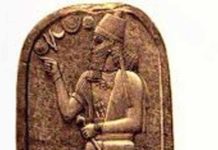Before the great city-states of ancient Sumer and Akkad people chose the caves and foothills of Kurdistan for their dwellings.
Many history books have but a few references to the geographical region known as Kurdistan because it is not a geopolitical entity. However the people of this region that encompasses parts of modern Turkey, Iran, Iraq and Syria have a common history that dates back to the dawn of civilization.
Today these people speak their own language and have a unique culture in spite of being at the crossroads of conquest since antiquity.
Prehistoric Kurdistan
According to the Kurdish peoples own traditions the modern Kurds can trace their origins back to the Mesolithic cultures of 11,000 years ago who first inhabited the region of Iraqi Kurdistan.These people left remains of walls built with field stones and traces of a thriving lithic industry that fashioned a variety of stone tools and awls made from bone. These early inhabitants may have wintered in thin walled mud-brick houses and made dietary staples out of the sheep and goats native to the region.
Here the ancient Kurds domesticated animals and developed their own mythology based on the forces of nature. Discoveries of fertility goddess statues have been found throughout the region where mountains and caves became sacred places. Many of these ancient sites, such as Sinjar Mountain in Iraq, still hold a spiritual significance for the regions modern inhabitants. In fact the modern Yezidi religion, practiced by over 500,000, people embraces traditions that date back to the Bronze Age.
For thousands of years the people of ancient Kurdistan remained partially isolated from the burgeoning growth of southern Iraq until when 8,000 years ago the Halaf and the Hassuna-Samarra cultures loosely united the region. The people that lived in the foothills of the Zagros Mountains that followed the Tigris River westward still remained somewhat removed from the urban expansion going on to the south. However, even with this isolation the region was a thoroughfare of trade between Anatolia, Mesopotamia and Iran as it had been since Paleolithic times.
So it was that for a few thousand years the ancient Kurds lived at the northern extreme of the Sumerian culture’s influence. This changed when around 2300 BCE Sargon the Great conquered all the lands along the Tigris River at least as far north as the region of Nineveh.
The Origin of the Name “Kurd”
What the ancient Kurds called themselves is a mystery. It is possible that the name Kurd may stem from the Sumerian word for mountain “KUR”. Several ancient documents from Sumer and Akkad may mention the Kurds but it is not until they are called the Guti in the decades following the collapse of Sargon’s Akkadian empire that we can say for certain that the mountain people of the Zagros have clearly entered history. The term Guti has itself been posited as an origin of the term Kurd which could be explained by the change of a few letters taking Guti to Gurt.
Hurrians, Lullubi and Gutians
With the death of Sargon the peoples of Northern Mesopotamia who had been forcibly dragged into history where free again. In the region of Urkesh at the base of the Taurus Mountains the first traces of a people known as the Hurrians became evident. To the east in the foothills of the northern Zagros, dwelled the Lullubi people and to their south, near modern Hamadan in Iran, lived the Gutians. Together these tribal peoples were hostile to the Kings of Sumer and Akkad and they were able to cut Mesopotamia off from its sources of copper, tin and silver.
In an effort to restore this trade Sargons’s grandson, Naram-sin, campaigned extensively in Kurdistan. His main campaign against the Lullubi is commemorated by a rock sculpture at Daband-i-Gawr in Iran and on the famous stele found in Susa which portrays Naram-Sin wearing the horned crown of a god.
The Kings of Akkad boasted of their conquests in the mountains where they enslaved the native peoples in vast mining and timbering efforts. In a tradition that would follow throughout history; once the frontier that held the enslaved people in place collapsed they followed the trade routes of their former masters, but this time they were the conquerors.
Unlike the Hurrians and Lullubi the Guti were never fully conquered by Akkad and were not quick to adopt the cuneiform system of writing and so they were seen by the Mesopotamian people as fearsome foreigners.
According to the Sumerian King List the “hordes of Gutium” had twenty one kings but few left any inscriptions. Although the term horde implies a large force, the Guti in reality likely never numbered more than several thousand warriors who were simply able to take advantage of the collapse of the political system in Sumer and Akkad. Without cooperation between the city-states the invaders plundered at will and occupied a few key cities such as Agade and Nippur.
There is however evidence that at least one king of the Guti, Erridu-Pizir, fought against the Hurrians and Lullubi in Kurdistan in defense of the diminished Akkadian Empire. Meanwhile, in the far south of Iraq many of the city-states enjoyed total freedom with the lifting of the yoke of Akkad and the lack of significant Guti conquests south of Nippur. The freedom of the southern cities allowed the ensi of Uruk, one Utuhegal, to lead an army from southern Iraq against “the stinging serpent of the hills’. Finally the foreign Guti were driven out of Mesopotamia and there king Tiriqan was captured.
Utu-Hegal’s success was short-lived and he was overthrown by the governor of Ur who was followed to the throne by his son Shulgi. Once again a new monarch in the south began to strive to control the Zagros foothills and for over four decades of his rule the Hurrians and the Lullubi of Kurdistan would be Shulgi’s objective continuing the pattern of conquest and re-conquest that would last for centuries.







